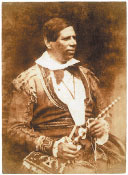Looking for surprises in the history of Christianity among Indigenous Peoples
A
s European settlers populated Canada, especially after the War of 1812, they moved Indigenous Peoples out of the way. Christianity had a complicated role to play in that history.
There have been two common narratives about Canadian churches and colonialism. The first, which many of us grew up with, was that the Euro-Canadian churches organized themselves to minister to Indigenous Peoples selflessly and self-sacrificially to relieve them of superstition and move them from primitive to civilized conditions.
Being both Indigenous and Christian was seldom easy then, just as it’s seldom easy now, in large part because the grand narratives make Indigenous Christianity appear anomalous.
The second is that the Euro-Canadian churches, captive to government policies, identified Indigenous Peoples as a problem that could best be solved through strategies of cultural assimilation.
These two grand narratives seem quite different, even opposite, but they have some premises in common. Both picture the churches as naturally Euro-Canadian bodies where Indigenous Christians are addenda. Both assume "Europe produced history and Natives submitted to it," as one author has ironically put it. Both maintain a binary distinction between Indigenous and settler identities.
But life is more complicated than these assumptions.
A number of historical studies of Christianity among Indigenous Peoples have therefore shunned generalizations and taken in-depth looks at complicated specific situations. Typically they recognize a lot more Indigenous agency in Indigenous church growth than either of the grand narratives.
For instance, strange as it may seem, some studies of the Mi’qmaq, the Nisga’a, the Tsimshian, and the Inuit of the eastern Canadian Arctic show some members of these nations were embracing Christianity before they had ever met a Western missionary. And even when a Western missionary did arrive, the principal agents of local Christianization were Indigenous catechists, evangelists, prophets and pastors.
In other words, Indigenous Christians weren’t fitting themselves into a Euro-Canadian version of Christianity, any more than 7th-century Anglo-Saxon and Celtic Christians in Great Britain made themselves Roman when a missionary arrived from the pope. They were all meeting Jesus in their own cultural context.
Being both Indigenous and Christian was seldom easy then, just as it’s seldom easy now, in large part because the grand narratives make Indigenous Christianity appear anomalous.

KAHKEWĀQUONĀBY PICTURED IN SCOTLAND ON AUG. 4, 1845
Take, for example, the bicultural Christian leader Kahkewāquonāby, known as Peter Jones, perhaps the most famous of early Indigenous Christian preachers and evangelists. He worked among his own Mississauga people in southern Ontario until his death in the 1850s, but faced the problem that his Christianity wasn’t Indigenous enough for many First Nations critics and not British enough for Euro-Canadian leaders.
Or take Edward Ahenakew (1885–1961), a Cree Anglican priest in Saskatchewan, who had to watch his step with his white bishop. He was silenced in the 1930s when he wrote against Indian residential schools, and had to hide his amazing projects for collecting traditional Cree stories, which were published only after his death.
The grand narratives also don’t leave room for the settler Christian allies who identified with Indigenous Peoples so strongly that they burned bridges to the white establishment.
Take Arthur O’Meara, an Anglican priest who was also a lawyer. After British Columbia denied the existence of all Indian land title in 1909, he dedicated his life to working with the Nisga’a on their land claims. By 1928 his marathon of publications, petitions, letters, meetings and advocacies had proven fruitless. He was vilified by the white elite because of what they characterized as fanaticism and alleged misunderstanding of Indigenous land title, and he died impoverished.
It was only in 1973 his vision was vindicated when the Nisga’a used his arguments to win a landmark ruling from the Supreme Court of Canada. The Calder case definitively established the legal existence of Indigenous land rights. (Frank Calder, who brought the case, was a Nisga’a Anglican who had studied for the priesthood at the University of British Columbia.)
In none of this am I suggesting settler colonialism wasn’t such a bad thing. It was a bad thing. The moral of the story, rather, is that it operated in a complicated way. The Holy Spirit blows where he will. The past is more surprising than the grand narratives want it to be.

Alan Hayes is professor of the history of Christianity at Wycliffe College, University of Toronto.